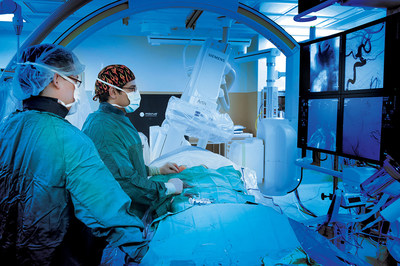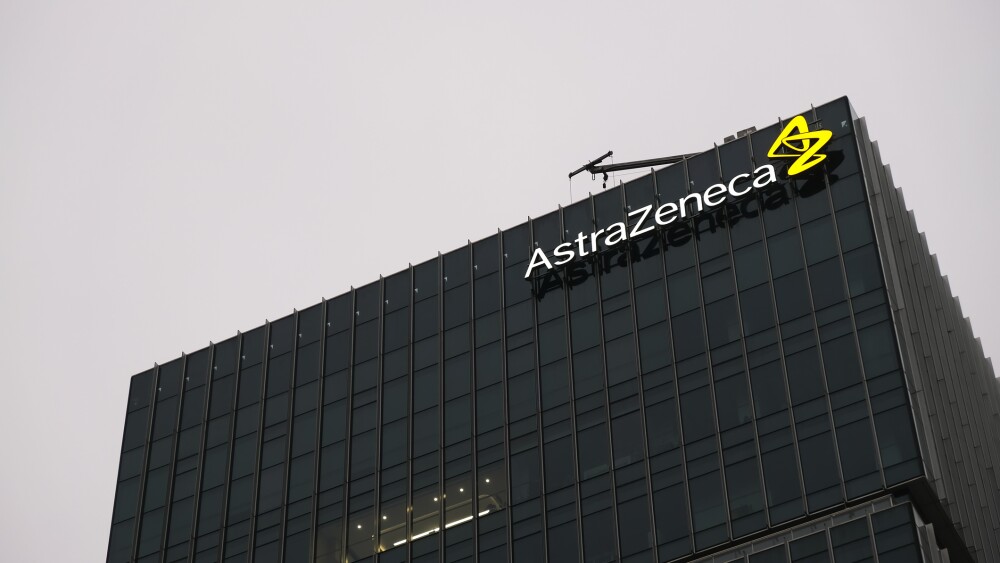A new procedure pioneered by Norton Healthcare physician-scientists directly targets brain tissue affected by radiation necrosis.
| LOUISVILLE, Ky., May 14, 2019 /PRNewswire/ -- A new procedure pioneered by Norton Healthcare physician-scientists directly targets brain tissue affected by radiation necrosis.
“I started losing my sight and then passed out,” Alyssa Coffey recalled about experiencing her first seizure. Coffey was in the midst of training for an upcoming bodybuilding competition. A scan revealed the then 23-year-old New Jersey resident had an arteriovenous malformation (AVM), a tangle of abnormal blood vessels connecting arteries and veins in the brain. To treat the AVM, doctors in her home state used radiation therapy. The radiation therapy treated the AVM, but Coffey experienced the severe side effect of radiation necrosis. Radiation therapy is an effective way to treat certain brain AVMs. In up to 5 percent of cases, however, it can cause damage to the surrounding brain. This can result in radiation necrosis, when the nearby brain tissue becomes injured and dies. The condition can be disabling, causing severe headaches, nausea and vomiting, seizures, cognitive issues and even death. Doctors use a variety of medications, such as steroids, to manage the symptoms. None of the medications works very well, and all have serious side effects. There is no approved cure. “It was miserable,” Coffey said. “The necrosis impacted my ability to work. Going to the gym was out of the question.” Doctors in New Jersey suggested exploratory brain surgery, but Coffey felt it was too risky. A NEW TRIAL FOR RADIATION NECROSIS Last year, while on an AVM support group website, Coffey learned about a study at Norton Neuroscience Institute in Louisville, Kentucky, and the University of Kentucky that sought to reverse radiation necrosis. The trial, led by Shervin Dashti, M.D., Ph.D., endovascular neurosurgeon with Norton Neuroscience Institute, is the first in the world to deliver a single small dose of the cancer drug Avastin directly to the area of the brain affected by the necrosis. Tom Yao, M.D., endovascular neurosurgeon with Norton Neuroscience Institute, and Justin Fraser, M.D., neurosurgeon with UK HealthCare, also are treating patients in the study. Avastin previously has been used effectively to treat radiation necrosis. The medication is given through an IV, meaning the drug has to circulate through the body before only a small percentage reaches the brain. When the drug does reach the brain, it has a hard time penetrating because of a natural defense mechanism called the blood-brain barrier. Making matters worse, exposing the body to Avastin can result in brain bleeds, clots and uncontrolled high blood pressure. What makes the new treatment innovative is it delivers a very small dose of Avastin directly into the artery going to the affected part of the brain. The smaller dose should significantly decrease the serious and life-threatening side effects of the drug. Also, with the targeted delivery, a lot more of the drug will get to where it needs to go. To make the drug more effective, Dr. Dashti uses a special technique to open the blood-brain barrier by infusing a mannitol sugar solution into the carotid artery. When this is done right before injecting the Avastin, a much larger amount of the drug can reach the affected brain tissue while minimizing drug exposure to the rest of the body. “I felt this was my best option,” Coffey said. “And I was confident it was going to work.” MEDICATION YIELDS POSITIVE RESULTS Coffey flew to Louisville to receive her single-dose treatment. In a 45-minute procedure, Dr. Dashti injected the Avastin into her brain through an artery in her leg and immediately began studying the effects. It didn’t take long for Coffey to see a difference. “The headaches went away in a matter of weeks,” she said. “I was able to go off my other medications and get back into the gym.” Her scans also told a positive story. “The images showed great improvement in the area impacted by the necrosis,” Dr. Dashti said. “We were very encouraged with what we were seeing.” STILL GOING STRONG — AND GETTING STRONGER It’s been a year since Coffey received her injection. She recently returned to Louisville for a follow-up exam. The headaches are now a distant memory, and her brain scans are showing further improvement. She said she’s feeling great and is even back to training for another bodybuilding competition. “Participating in the trial was the best thing I could have done,” she said. “I’ve received tremendous care throughout. I feel like I have my life back.” Dr. Dashti said other patients in the trial also are seeing similar results. “To this point, everyone who has received the Avastin has seen improvement in their condition,” he said. “It’s very exciting.” While the findings are encouraging, Dr. Dashti points out that the treatment is still a long way from becoming common practice. “We studied a very small group of people, and we still have to determine if the benefits are long-term,” he said. “Hopefully, we’ll look to get funding for a larger, multicenter study in the future.” For now, he’s excited about the possibilities. “I think we have a chance to change the way we treat radiation necrosis and help more people,” Dr. Dashti said. You can be a part of life-changing work at Norton Neuroscience Institute. Make a donation to the Norton Healthcare Foundation to help.
SOURCE Norton Healthcare |







